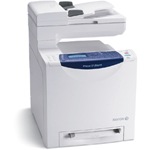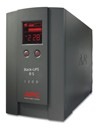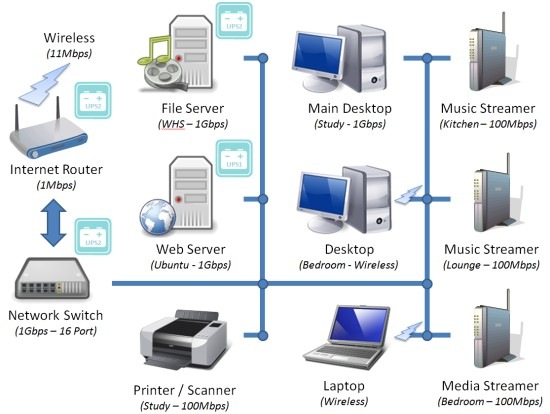 |
| Photo by jessicafm |
My home network was never planned (it just kind of happened), but since its inception it grew rapidly to meet my ever expanding needs. For along time it more than met my requirements, but as is inevitable, I began to demand more of it than it could comfortably provide. So after much deliberation I have just completed a long awaited and much needed upgrade.
My home network originally grew from having a single Laser printer connected directly to my PC, to having my house wired throughout with CAT5e network cable, with every room having potential access to the Internet and a central file server. The file server was responsible for storing all of the household’s data (user files, music and pictures etc.).
My file server (an old 300MHz Compaq) was probably passed its sell by date when I first installed it, but after 5 years of continuous use it was certainly struggling to keep up. This, coupled with the fact that my storage capacity of 100GB was almost maxed out, meant that it really was time to upgrade!
Office Refit
The first part of my network upgrade was instigated by the redecoration and remodelling of my study after much planning with the aid of Google SketchUp (a free and remarkable bit of 3D modelling software).
 As part of the reorganisation I wanted to keep my new office space as uncluttered as possible. Prior to this (apart from my main PC) the study played home to the following office equipment to meet my printing and scanning needs:
As part of the reorganisation I wanted to keep my new office space as uncluttered as possible. Prior to this (apart from my main PC) the study played home to the following office equipment to meet my printing and scanning needs:
- HP LaserJet 5p Laser Printer
- Intel NetportExpress PRO Print Server
- Cannon LIDE 50 USB Scanner
- Epson R300 USB Colour Inkjet Printer
Network Printing
 While the little HP Laser printer had given me sterling service over the years (and was in fact the origin of my home network) it was time to retire it. I decided to combine four devices into one with the purchase of a network connected Xerox Phaser 6128MFP-N colour laser printer with integrated scanner.
While the little HP Laser printer had given me sterling service over the years (and was in fact the origin of my home network) it was time to retire it. I decided to combine four devices into one with the purchase of a network connected Xerox Phaser 6128MFP-N colour laser printer with integrated scanner.
Apart from saving valuable desk space, this now enabled quick photocopies to be made without having to boot up my desktop PC.
Fast and Furious
As part of the long term plan to upgrade my network, I had previously installed a Gigabit (1Gbps, 1,000Mbps) network switch so that I could transfer large files (such as video) around the network 10 times faster than the standard 100Mbps.
Luckily, my installed cabling was already 1Gbps compatible and my desktop PC had a 1Gbps Ethernet card installed. Up until now however, no other devices on the network were 1Gbps capable. Time to remedy the situation…
Server Upgrade
As my old server was used not only as a general file server, but also as a development web server, I decided to split the new server system into two; one running Linux for web site development, and a second running Microsoft Windows Home Server with a few terabytes of storage for music, pictures and video.
Windows Home Server
 After much deliberation I opted for the HP Data Vault X510 for my Windows Home Server (WHS) box. The particular version that I chose came fitted with two 1.5TB discs giving a potential storage capacity of 3TB; a 30 fold increase over my old system.
After much deliberation I opted for the HP Data Vault X510 for my Windows Home Server (WHS) box. The particular version that I chose came fitted with two 1.5TB discs giving a potential storage capacity of 3TB; a 30 fold increase over my old system.
This server now holds all of my music, photos, general user files plus a selection of DVDs and videos.
Videos
To store my DVD collection on the new WHS box, I use a free little utility called DVD Shrink. This great little utility rips a DVD in about 15 minutes to a file of about 5GB. The program also enables you to remove the menus and trailers so that you can get straight into a film.
Linux Web Server
 The second half of my server upgrade was via a retired Dell PowerEdge 2850 rack server that was kindly donated to me by a friend who luckily happens to own a large UK Internet Service Provider; Zen Internet (thanks Rich!). So please excuse the shameless plug.
The second half of my server upgrade was via a retired Dell PowerEdge 2850 rack server that was kindly donated to me by a friend who luckily happens to own a large UK Internet Service Provider; Zen Internet (thanks Rich!). So please excuse the shameless plug.
The Dell server is a bit of a beast and rather noisy and as such was consigned to the garage. The garage wasn’t originally included in my home network (or its upgrade plan), but with my Google like megalomania taking hold I ran two additional network cables into the garage to facilitate the expansion of my burgeoning data centre.
This server is running a server version of Ubuntu Linux, configured with an Apache web server, PHP and MySQL database server; a configuration often referred to as LAMP (Linux, Apache, MySQL and PHP). I’ve also installed Webmin on the server so that I can remotely administer it via a web browser interface.
Data Protection
 Backups
Backups
One of the reasons that I chose Windows Home Server, is that every day it automatically backs-up every client computer connected to the network. This works flawlessly with my three client machines being backed up regularly, giving a little extra peace of mind.
Data Redundancy
The WHS box also has folder duplication, so that important files are duplicated on two discs. Thus in the event of a single disc failure, no valuable data should be lost.
While the Linux server data is also protected in a similar manner, with its files being stored on a RAID1 disc array (meaning all data is duplicated across two identical drives), I have also configured it to backup its key data files across the network weekly onto the WHS box for increased protection.
Uninterruptible Power

As I completely rely on my computer systems and their data integrity, I decided to protect the two new servers with Uninterruptble Power Supplies (UPSs). For this function I bought two APC UPSs, both connected to their respective servers via USB so that the servers know when the battery backup is running low, enabling them to shut themselves down in a controlled and safe manner.
Taking Stock
 My home network now comprises:
My home network now comprises:
- My Desktop PC
- Laptop (wireless)
- My son’s PC (wireless)
- Network Printer/Scanner
- File Server (music, pictures, videos and files)
- Development Web Server (Linux)
- Music Player (kitchen)
- Music Player (lounge)
- Media Player (bedroom)

Every room in the house now has at least two network connection points, each giving access to:
- Broadband internet 24/7
- Network printing and scanning
- My entire music collection
- A selection of my videos and DVDs
- All of the family pictures
- Central file storage and backup
- Home intranet
Future Plans
After such an upgrade you’d think that my network would be complete for a while, but it doesn’t take long before the mind starts ticking over and improvements are sought.
The first immediate areas that I think require some attention are:
- Additional Backup for WHS: This is my weak link for data safety at the moment.
- New Router: My router presently only supports 11Mbps wireless, so it could really do with upgrading. A new router would also allow me to accept the higher speed ADSL options that are around the corner, which my current router won’t support.
After that, who knows…

Tells me when I try to launch the game that I need to be an administrator the first time that i launch the program and that I have insuffficient athority. I am an administrator, I am the only one who uses my computer and the only profile on it is mine, so I have to be the administrator. How can I get this to work, or is it just a Windows 7 problem?
Unfortunately I don’t have any experience of Windows 7, have you tried searching some of the online forums? Like you say, I would have expected you to be an administrator. Try going into the user profiles from the control panel and double check the administrator privileges.
This is a great article. I like the integration of systems and rationale, and I very much appreciate the diagram you provided.
I am considering use of ClearOS as I have become disenchanted with Windows Server 2008. I’d be interested in hearing your thoughts on it….
-Mike
Hi, Glad you liked the article, thanks. I’ve no direct experience with ClearOS, but a friend of mine has used it to setup a family home network and thinks it’s wonderful; very easy to configure and administer apparently.
What a home network ? I own more than 10 computers at home but home networking with microsoft windows due faulty horrible terrible os is almost impossible task ! I can not understand how people can use home networking under ms and even less with mixed environment ! I know all about home networking with ms and how is properly setup but simply is not reliable and trouble all the time ! Its working but only 10% another 90% it is faulty access denial despite opposite settings … well all the common troubles reported all over internet ! I’m in the best mood to dump ms for good as native installed os ! I can not belive how stupid we user are to pay ms for such faulty os ! It is only good for running games/internet but here are problems too but no so significant as home networking ! We re living in 21st and now we have 4 core cpu in hand held
devices so powerful as some home computer but still home networking is a non workable nightmare ! Don’t drill me of howto’s i know it all !!! And now i will tell you how i solved home networking problems ! It’s a 100% working solution regardless when or how ! First of all go to local computer store and buy some big usb external drive for file transfer purposes ! Now copy/transfer to it and manualy in prehistoric old fashion manor transfer it to other computer (may be time and footprint involved), for printer sharing may come some portable printer very handy not to heavy one or someone is to blaim ms for becomming ”schwarzeneger” – no need for local body building (o yes MS can take credit for that too) ! Some would’nt agree with that as some NAS/home server can be used instead but one may forget that using home networking with ms all computers on the grid must be 100% network operational ! In practice that means that every computer os must be 100% network operational but is not due common ms problems so from that faulty computer os one can not acces home network so NAS/Home Server is useless even it is operational one !!! With wireless we have security problems if one secures wireless it may become unaccessible and the same problems occurs again ! And MS is doing nothing to improve simplify to being user friendly os for that task ! We have tons of networking software developed for ms and all of them are also useless due all are based on proper ms network setup ! If something go wrong with them then os isnt network operational and all that soft is useless again ! As today i do have not found app that would be implement independent home networking or working in parallel wit ms !
For developed tech point of view today this should be setup and forget and not setup and administer troubleshooting all the time with plug and pray involvement ! In near future i get some optical wire internet access and then i will replace all my network with optics home network and then i will probably use MAC and some Linux ! MS is to faulty and is god enough only for some simple internet home office and games use nothing more/nothing less ! I rely admire people who can use ms/mixed home networking environment effectively ! All my OS that i currently use are Win XP Pro SP3 and Win Server 2003 with 1GB min and 4 GB max RAM on each comp ! I don’t bother with VISTA Win 7 and Server 2008 – as home networking with it is even more complicated some setup access is removed and troubleshooting wizard takes unresonable time to complete ! They are over sized and unresonable hardware demanding OS ! Eye catcher lifted up os today is beautiful to see but that is not good enough its that what is under the hood what matters and ms home networking isnt eye catcher at all ! Look at openVMS how networking is to be done and not faulty MS ! Windows was designed for office and portable office use and then for games and internet and no wonder that so many problems with it due to home networking ! I have setup home networking with Win 2003 server but that also is not working all the time but better then Win XP but not good enough and when is most needed don’t work at all ! So using prehistoric manual file transfer way all the time with some body building involved ! So my regards to your working home network i will wait for optics and then we will see !!! I have more than 10 years experience with MS and friend of mine owns some small local IT store ! And when something needs to be setup i’m in charge ! People are buying all sort of hardware and the major problem occurs when they try to interconnect them ! Hard/soft vendors advertise/promises a lot but in praxis this means huge trouble when its comes to interconnections of devices what networking is ! If it works first time ok, when not there will be non stop troubles and i do advise people if they own legal licensed windows that they should go to MS and kick some ass there as is 99% ms fault ! I have enough knowledge to say what is probably making trouble ! And i have duped network support for friends customers as due known networking problems with MS !
PS: If someone has desperate need to pass this to MS go ahead and do so (they all ready knows that home networking is very problematic but they keep low profile on it and advertise further) ! I don’t bother with them any more, they are like mastodont dinosaurus just waiting for some meteor to wipe them out ! My advice don’t buy MS, look else where and test first. Non MS solution might work much better and some are open source !
I’m very desperate MS user as home network is involved and i wonder how come that enterprises and corporations that uses MS is not packing MS by the balls and sue MS ass as they are facing exactly with the same problems ! No wonder that majority of IT corporations uses non MS solutions like IBM … For info only – years ago Germany State and public services has gone Linux and some big enterprises too ! They have enough (as my self) of ”smoking gun” tubokapitalsm economics attempt with faulty unreliable non stop problematic os for which licenses for using it in commercial way are to pay on year basic not to having what we pay for !
Anonymous should consider MS to be taken down as they more than deserve it !
Wow, quite the set up! I don’t have quite that many clients hooked up to my router at home, but even with my two computers and a printer I find bugs popping up all the time. I only have one computer backed up full time, but I don’t have dedicated power backups. Where did you get the UBSs’s? Those would give me some piece of mind for sure.
You’re not wrong there. Having a powerful home network is brilliant; the downside is you are the systems administrator and have to solve all of the family’s computing problems. The UPSs are indeed very handy to have as I live in the countryside, so often get brief power outages. The UPSs I went for were made by APC and most decent computer hardware websites should sell them.
It is very nice to get a chance to go through your informative piece of writing. A lot of vague aspects have been made clear with your thoughts.